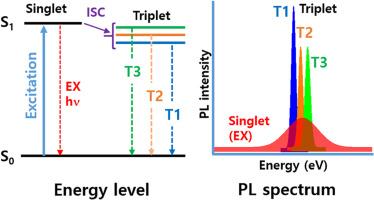Simultaneous bright singlet and triplet emissions in CsPbBr3 nanocrystals for next-generation light sources
IF 9.7
2区 材料科学
Q1 MATERIALS SCIENCE, MULTIDISCIPLINARY
引用次数: 0
Abstract
Lead halide perovskite nanocrystals exhibit excellent optoelectronic properties, yet simultaneous observation of bright singlet and triplet exciton emissions under identical conditions has remained elusive. This limitation hinders optimization of quantum efficiency in light-emitting devices. Here, we provide the direct spectroscopic evidence for coexisting bright singlet and triplet excitons in CsPbBr3 nanocrystals, overcoming the conventional 25 % spin-statistical efficiency ceiling. Using polarization-resolved, spatially resolved, and time-resolved micro-photoluminescence at 7 K, we resolve three sharp triplet fine-structure components (T1, T2, T3) with energy separations of 1–3 meV and linear polarization >85 %, coexisting with broad singlet emission. The triplet emissions display distinct polarization axes, nonlinear intensity scaling, and nanosecond lifetimes, confirming their assignment as Rashba-split bright triplet states. Spatial mapping reveals that these emissions arise from structurally pristine domains with exciton diffusion lengths exceeding 9 μm. Time-resolved measurements show concurrent fast and slow decay components, consistent with singlet-to-triplet intersystem crossing followed by radiative triplet recombination. Our findings establish a comprehensive picture of exciton spin dynamics in perovskite nanocrystals and open new avenues for spin-engineered photonic devices. This work lays the foundation for next-generation LEDs, lasers, and quantum light sources that leverage both singlet and triplet radiative channels to exceed traditional efficiency limits. While these findings are demonstrated at cryogenic temperatures, they highlight essential spin-related mechanisms that could be harnessed for room-temperature operation through enhanced Rashba coupling, dielectric engineering, or compositional tuning.


用于下一代光源的CsPbBr3纳米晶体的同时亮单线态和三重态发射
卤化铅钙钛矿纳米晶体具有优异的光电性能,但在相同条件下同时观察明亮的单线态和三重态激子发射仍然难以实现。这一限制阻碍了发光器件量子效率的优化。在这里,我们提供了CsPbBr3纳米晶体中同时存在明亮的单线态和三重态激子的直接光谱证据,克服了传统的25%的自旋统计效率上限。利用偏振分辨、空间分辨和时间分辨的微光致发光技术,我们在7 K下分辨出三个尖锐的三重态精细结构成分(T1, T2, T3),它们的能量分离为1-3 meV,线性极化>;85%,与宽单线态发射共存。三重态发射显示出明显的极化轴、非线性强度缩放和纳秒寿命,证实了它们属于rashba分裂的明亮三重态。空间映射表明,这些发射来自于激子扩散长度超过9 μm的结构原始域。时间分辨测量显示同时存在快速和慢速衰变成分,与单重态到三重态的系统间交叉相一致,然后是辐射三重态复合。我们的发现建立了钙钛矿纳米晶体中激子自旋动力学的全面图景,并为自旋工程光子器件开辟了新的途径。这项工作为下一代led、激光和量子光源奠定了基础,这些光源利用单线态和三重态辐射通道来超越传统的效率限制。虽然这些发现是在低温下证明的,但它们强调了可以通过增强Rashba耦合、介电工程或成分调谐来用于室温操作的基本自旋相关机制。
本文章由计算机程序翻译,如有差异,请以英文原文为准。
求助全文
约1分钟内获得全文
求助全文
来源期刊

Materials Today Physics
Materials Science-General Materials Science
CiteScore
14.00
自引率
7.80%
发文量
284
审稿时长
15 days
期刊介绍:
Materials Today Physics is a multi-disciplinary journal focused on the physics of materials, encompassing both the physical properties and materials synthesis. Operating at the interface of physics and materials science, this journal covers one of the largest and most dynamic fields within physical science. The forefront research in materials physics is driving advancements in new materials, uncovering new physics, and fostering novel applications at an unprecedented pace.
 求助内容:
求助内容: 应助结果提醒方式:
应助结果提醒方式:


